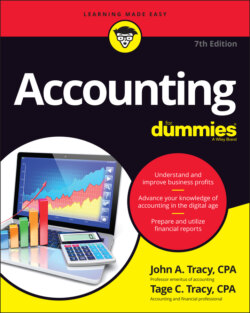Читать книгу Accounting For Dummies - John A. Tracy - Страница 39
Presenting the components of the income statement
ОглавлениеFigure 2-1 presents the major ingredients, or information packets, in the income statement for a technology company that sells products and services. As you may expect, the income statement starts with sales revenue on the top line. There’s no argument about this, although in the past, certain companies didn’t want to disclose their annual sales revenue (to hide the large percent of profit they were earning on sales revenue).
Sales revenue is the total amount that has been or will be received from the company’s customers for the sales of products and services to them. Simple enough, right? Well, not really. The accounting profession is currently reexamining the technical accounting standards for recording sales revenue, and this has proven to be a challenging task. Our business example, like most businesses, has adopted a certain set of procedures for the timeline of recording its sales revenue.
Recording expenses involves much more troublesome accounting problems than revenue problems for most businesses. Also, there’s the fundamental question regarding which information to disclose about expenses and which information to bury in larger expense categories in the external income statement. We say much more about expenses in later chapters. At this point, direct your attention to the five kinds of expenses in Figure 2-1. Expenses are deducted from sales revenue to determine the final profit for the period, which is referred to as the bottom line. Actually, the preferred label is net income, as you see in the figure.
The five expense categories you see in Figure 2-1 should almost always be disclosed in external income statements. These constitute the minimum for adequate disclosure of expenses. The cost of goods sold or cost of sales (for service companies) is just what it says: the cost of the products sold or services delivered to customers. The cost of the products or services delivered should be matched against the revenue from the sales, of course.
© John Wiley & Sons, Inc.
FIGURE 2-1: Income statement information components for a technology company that sells products and services.
Only one conglomerate operating expense has to be disclosed. In Figure 2-1, it’s called selling, general, and administrative expenses, which is a popular title in income statements. This is an all-inclusive expense total that mixes together many kinds of expenses, including administrative employee wages and benefit costs, advertising expenses, depreciation of assets, and so on. But it doesn’t include interest expenses, income tax expenses, or other expenses; these three expenses are generally reported separately in an income statement.
The cost of goods sold or cost of sales expense and the selling, general, and administrative expenses take the biggest bites out of sales revenue. The other three expenses (interest, income tax, and other expenses) are relatively small as a percent of annual sales revenue but are important enough in their own right to be reported separately. And though you may not need this reminder, bottom-line profit (net income) is the amount of sales revenue in excess of the business’s total expenses. If either sales revenue or any of the expense amounts are wrong, then profit is wrong.
A service business does not sell products; therefore, it doesn’t have the traditional cost of goods sold expense (as it is not selling any tangible goods). In place of cost of goods sold, a service business often simply refers to the direct costs as costs of sales, which generally capture labor expenses for wages, payroll taxes, benefits, and other expenses that directly vary with sales revenue. Most service businesses are labor intensive; they have relatively large labor costs as a percent of sales revenue. Service companies differ in how they report their operating expenses. For example, United Airlines breaks out the cost of aircraft fuel and landing fees. The largest expense of the insurance company State Farm is payments on claims. The movie chain AMC reports film exhibition costs separate from its other operating expenses. We offer these examples to remind you that accounting should always be adapted to the way the business operates and makes profit. In other words, accounting should follow the business model.
